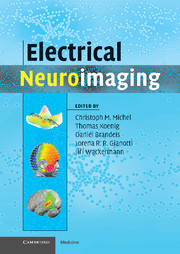Book contents
- Frontmatter
- Contents
- List of contributors
- Preface
- 1 From neuronal activity to scalp potential fields
- 2 Scalp field maps and their characterization
- 3 Imaging the electric neuronal generators of EEG/MEG
- 4 Data acquisition and pre-processing standards for electrical neuroimaging
- 5 Overview of analytical approaches
- 6 Electrical neuroimaging in the time domain
- 7 Multichannel frequency and time-frequency analysis
- 8 Statistical analysis of multichannel scalp field data
- 9 State space representation and global descriptors of brain electrical activity
- 10 Integration of electrical neuroimaging with other functional imaging methods
- Index
- References
2 - Scalp field maps and their characterization
Published online by Cambridge University Press: 15 December 2009
- Frontmatter
- Contents
- List of contributors
- Preface
- 1 From neuronal activity to scalp potential fields
- 2 Scalp field maps and their characterization
- 3 Imaging the electric neuronal generators of EEG/MEG
- 4 Data acquisition and pre-processing standards for electrical neuroimaging
- 5 Overview of analytical approaches
- 6 Electrical neuroimaging in the time domain
- 7 Multichannel frequency and time-frequency analysis
- 8 Statistical analysis of multichannel scalp field data
- 9 State space representation and global descriptors of brain electrical activity
- 10 Integration of electrical neuroimaging with other functional imaging methods
- Index
- References
Summary
The present chapter gives a comprehensive introduction into the display and quantitative characterization of scalp field data. After introducing the construction of scalp field maps, different interpolation methods, the effect of the recording reference and the computation of spatial derivatives are discussed. The arguments raised in this first part have important implications for resolving a potential ambiguity in the interpretation of differences of scalp field data.
In the second part of the chapter different approaches for comparing scalp field data are described. All of these comparisons can be interpreted in terms of differences of intracerebral sources either in strength, or in location and orientation in a nonambiguous way.
In the present chapter we only refer to scalp field potentials, but mapping also can be used to display other features, such as power or statistical values. However, the rules for comparing and interpreting scalp field potentials might not apply to such data.
Generic form of scalp field data
Electroencephalogram (EEG) and event-related potential (ERP) recordings consist of one value for each sample in time and for each electrode. The recorded EEG and ERP data thus represent a two-dimensional array, with one dimension corresponding to the variable “time” and the other dimension corresponding to the variable “space” or electrode. Table 2.1 shows ERP measurements over a brief time period. The ERP data (averaged over a group of healthy subjects) were recorded with 19 electrodes during a visual paradigm. The parietal midline Pz electrode has been used as the reference electrode.
- Type
- Chapter
- Information
- Electrical Neuroimaging , pp. 25 - 48Publisher: Cambridge University PressPrint publication year: 2009
References
- 14
- Cited by



